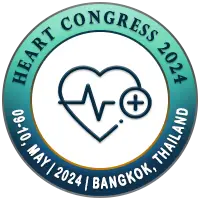
Kasturi Markandran
National University of Singapore, SingaporeTitle: Anthracycline-induced Cardiotoxicity–An Endothelial Perspective
Abstract
Cardiotoxicity is a major concern associated with anthracyclines. Although cardiomyocytes are the main cellular target of anthracycline-induced cardiotoxicity (AIC), recently endothelial cells, have been identified as a potential additional target. It is hypothesised that anthracycline-induced cellular injury disrupts endothelial lining increasing anthracycline exposure to cardiomyocytes, aggravating cardiotoxicity. Thus, we aim to correlate endothelial injury marker (i.e. circulating endothelial cells (CECs)) to cardiomyocyte injury marker (i.e. Troponin T).This is a prospective single centre study, consisting of 23 boys and 7 girls with a median age of 13 years. Bloods were collected at four time points: pre-treatment, end-treatment, 3-months posttreatment and 1-year post-treatment. Blood components were separated by gradient centrifugation and mononuclear cells (PBMCs) component was isolated. CECs were identified in PBMCs via immunostaining and flow cytometry. ELISA was used to measure cardiac biomarkers (TnT, NTproBNP) in the plasma. Echocardiography and NTproBNP assay was performed at each timepoint to monitor cardiotoxicity. An increase of CECs from pre- to end-treatment, (although not of statistical significance) suggests anthracycline-induced endothelial injury, although its extent has been overshadowed by injuries prior to anthracycline treatment, potentially due to the cancer itself. The significant decrease in CECs from end- to 3-months post-treatment demonstrates a connection between the decline in endothelial injury and the absence of anthracyclines. The CECs decreased to below pre- levels by 3-months post- and was sustained at 1-year osttreatment. TnT levels increased significantly from pre- to endtreatment demonstrating anthracycline-induced cardiomyocyte injury. The levels decreased significantly from end- to 3-months post-treatment but only returned to pre- levels by 1-year posttreatment, showing that myocardial injury is prolonged compared to endothelial injury and suggesting that endothelial injury could aggravate cardiac injury. As anticipated, cardiotoxicity is absent based on echocardiography and NTproBNP data underscoring clinicians' efforts in preventing it. Nonetheless, it is demonstrated that AIC could be attributed to myocardial and endothelial injury and that endothelial injury may aggravate myocardial injury.
Biography
Kasturi Markandran received her PhD from Nanyang Technological University, Singapore, and presently serves as a research fellow in the Department of Paediatrics at the National University of Singapore. Her research pursuit is to understand the role of endothelial cells in cardiovascular diseases. She is also intrigued by genetic and epigenetic regulation in cardiovascular diseases and has plans to pursue it.

